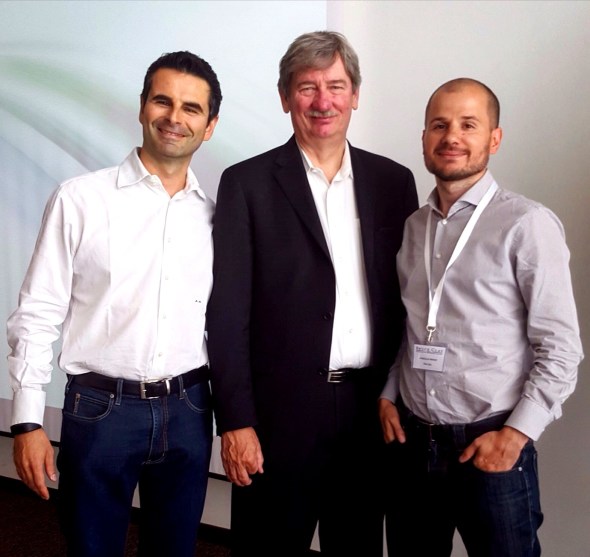My Key Takeaways From Bruce Clay’s Advanced SEO Class In Milan
June 12th, 2016
I recently took part to a 2-days class held by SEO legend Bruce Clay, president of Bruce Clay, Inc. and pioneer of SEO since 1996. Here are some quick notes on the status of SEO in 2016 and other interesting sub-topics covered during the class.

A photo with Bruce Clay and Ale Agostini
- Google is in the business of making money. Bruce repeated this “mantra” several times. It seems obvious, but we have to remember that Google wants you to pay for getting high posintions on its SERPs. This explains the recent changes in the layout of Google’s SERPs with increased visibility for paid search results, especially on mobile. And this also explains why Google does not like giving too much information that can help people to increase organic traffic.
- 58% of people do not recognize paid search as advertising.
- 55% of all search queries are 4 or more words.
- 1-word queries get a lot of impressions but fewer clicks. This suggest that a common behaviour is to try a simple 1-word query, then refine it with a more complex one, as the results are often unsatisfactory.
- 20% of searches each day are new or haven’t been completed in the past 6 months.
- 70% of queries have no exact-matched keyword. This is of course a great opportunity for SEO.
- Increased visibility for news content. If your page is recognized as a news for a specific topic, it can gain a very high visibility on top of Google’s SERPs, bringing you important peaks of traffic (but only for a limited time).
- Local SEO is critical. Map and local results get a boosted visibility on Google, espcially on mobile. It is critical to presidiate Google My Business (former Google Places) and other local directories with name, address and phone number for any touchpoint you have in the real world.
- Top three in SEO, Local and PPC is what will get 90% of all traffic within 2 years. Relying on organic traffic alone is not an option in 2016, with local rankings and PPC growing and consuming a lot of SERP space, especially on mobile (which is also growing a lot).
- Click-thorugh rate by position is not linear on mobile. Of course everyone knows that the higher you rank on a SERP, the most click you get. This is actually not so true on mobile, where position #4 gets a higher CTR than position #3 due to page scroll.
- Content optimization, SEO-related technicalities and link building are equally important in a SEO strategy. This is a specific question I made to Bruce during a break in order to understand if we should prioritize something among those three “SEO macro-factors”. The answer is that we should consider them all priority-1 items.
- The top ranking goes to the E-A-T websites. Where “E” stands for Expertise, “A” for Authoritativeness and “T” for Thrustworthiness. So it’s very important to offer fresh, original and complete content, and to demonstrate an optimal maintenance level on a more thechnical perspective. “Stale” is a sign of a poorly maintained website. The Google Quality Rating Guidelines (Nov. 2015) can be considered as a detailed reference.
- Different people get different results for the same query. Google SERPs are getting always more and more personal, taking into account many factors such as search history, behavior, intent and localization.
- The intent of a website is defined by how its pages appear to the eye of Google. An e-commerce page should be shorter, with fewer words (300 to 400), more and smaller images, more links and fast load. Instead, a website with a focus on research intent should have longer pages, with more than 500 words, less images (but bigger), less links and relatively slower load
- Google is increasing rank of short pages. Until some time ago, 1000 words were the minimum limit for creating SEO-relevant content. Now that limit decreased to 500 words more or less.
- 302 redirects can cause problems and should always be avoided. Just take note of this.
- Words on images are now recognized by Google. If you scan a newspaper article, put it on a PDF and make it visible to Google, you will get the text indexed.
- The title tag should be first in the <head> section, be unique for every page and be 6-12 words and 62-70 characters to avoid ellipsis.
- The meta description tag should be second in the <head> of a page, should be around 18 words and should use a word for a maximum of 2 times.
- Google never really said that the keywords metatag is not considered! So we should continue including it in the <head> of our pages. It should include around 36 words.
- Never purchase links. Advertisment are a valid exception, but you should add a “nofollow” attribute to them.
- The most important SEO technique is: your pages must not be considered as SPAM by Google. This leads to very long penalties and brought companies to failure.
- You should care about the quality of inbound links. Removing low-quality links improves ranking. Link from poor trust or inorganic topic sites will harm your ranking.
- Accelerated Mobile Pages (AMP) are not strongly recommended for now. They are time-consuming in terms of technical setup and they add limits in terms of layout and advertising options. But we should keep an eye on this project.